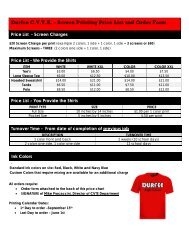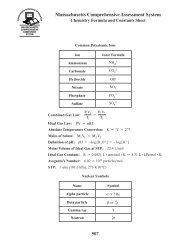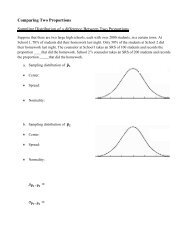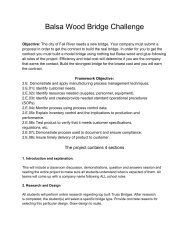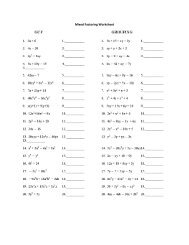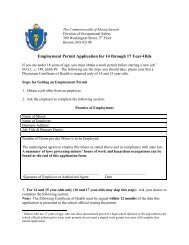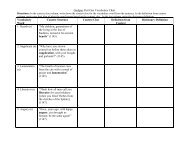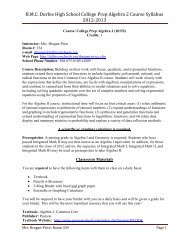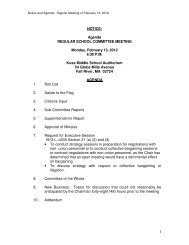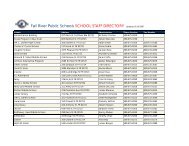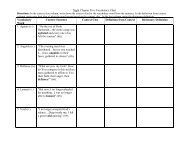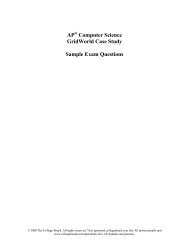Families - Right Choice for Kids
Families - Right Choice for Kids
Families - Right Choice for Kids
- No tags were found...
You also want an ePaper? Increase the reach of your titles
YUMPU automatically turns print PDFs into web optimized ePapers that Google loves.
A Guide <strong>for</strong><strong>Families</strong>UsingNAEYCStandardsto FindQualityPrograms<strong>for</strong> YoungChildrenwww.rightchoice<strong>for</strong>kids.org
The National Association <strong>for</strong>the Education of Young Children(NAEYC) has set 10 standards <strong>for</strong>early childhood programs thatcan help families make the rightchoice when they are looking <strong>for</strong>a child care center, preschool, orkindergarten. This introductionto the standards can guide yourfamily in finding a program inwhich your children can learn andgrow. The standards (and morethan 400 related criteria) are basedon research on the developmentand education of young childrenand were created with input fromthousands of experts and educatorsfrom around the country. Thestandards define what NAEYC—the world’s largest organization ofearly childhood professionals—believes all early childhoodprograms should provide.The standards and criteria are alsothe foundation of the NAEYCaccreditation system <strong>for</strong> earlychildhood programs. To earnNAEYC Accreditation, programsmust meet all 10 standards.
STANDARD 1—RelationshipsThe program promotes positive relationships amongall children and adults. It encourages each child’ssense of individual worth and belonging as partof a community and fosters each child’s ability tocontribute as a responsible community member.Warm, sensitive, and responsive relationshipshelp children feel secure. The safe and secureenvironments built by positive relationships helpchildren thrive physically, benefit from learningexperiences, and cooperate and get along with others.What you want to see in a program• Children and adults feel welcome when they visitthe program. Teachers help new children adjust tothe program environment and make friends withother children.• Teaching staff engage in warm, friendlyconversations with the children and encourage andrecognize children’s work and accomplishments.• Children are encouraged to play and work together.• Teachers help children resolve conflicts byidentifying feelings, describing problems, andtrying alternative solutions. Teaching staff neverphysically punish children.STANDARD 2—CurriculumThe program implements a curriculum that isconsistent with its goals <strong>for</strong> children and promoteslearning and development in each of the followingareas: social, emotional, physical, language, andcognitive. A well-planned written curriculumprovides a guide <strong>for</strong> teachers and administrators.It helps them work together and balance differentactivities and approaches to maximize children’slearning and development. The curriculum includesgoals <strong>for</strong> the content that children are learning,planned activities linked to these goals, dailyschedules and routines, and materials to be used.NAEYC and the NAEYC accreditation system donot prescribe a specific curriculum; programs candesign their own or choose a commercially availablecurriculum that meets NAEYC’s guidelines.
“Valued teachers lead to valuedchildren … Accredited programstend to attract employees who not onlyview themselves as educators, theyconsider themselves child advocates.”— Kate in San Antonio, Texasher child attends anNAEYC-Accredited program.
What you want to see in a program• Ask about the program’s curriculum and how itaddresses all aspects of child development. Thecurriculum should not focus on just one area ofdevelopment.• Children are given opportunities to learn anddevelop through exploration and play, and teachershave opportunities to work with individualchildren and small groups on specific skills.• Materials and equipment spark children’s interestand encourage them to experiment and learn.• Activities are designed to help children get betterat reasoning, solving problems, getting along withothers, using language, and developing other skills.• Infants and toddlers play with toys and artmaterials that “do something” based on children’sactions, such as jack-in-the-box, cups that fit insideone another, and playdough.STANDARD 3—TeachingThe program uses developmentally, culturally, andlinguistically appropriate and effective teachingapproaches that enhance each child’s learningand development in the context of the curriculumgoals. Children have different learning styles,needs, capacities, interests, and backgrounds. Byrecognizing these differences and using instructionalapproaches that are appropriate <strong>for</strong> each child,teachers and staff help all children learn.What you want to see in a program• Teachers carefully supervise all children.• Teachers provide time each day <strong>for</strong> indoor andoutdoor activities (weather permitting) andorganize time and space so that children haveopportunities to work or play individually and ingroups.• Children’s recent work (<strong>for</strong> example, art andemergent writing) is displayed in the classroom tohelp children reflect on and extend their learning.• Teachers modify strategies and materials torespond to the needs and interests of individualchildren, engaging each child and enhancinglearning.
STANDARD 4—Assessment of Child ProgressThe program is in<strong>for</strong>med by ongoing systematic,<strong>for</strong>mal, and in<strong>for</strong>mal assessment approaches toprovide in<strong>for</strong>mation on children’s learning anddevelopment. These assessments occur within thecontext of reciprocal communications with familiesand with sensitivity to the cultural contexts inwhich children develop. Assessment results benefitchildren by in<strong>for</strong>ming sound decisions, teaching,and program improvement. Assessments helpteachers plan appropriately challenging curriculumand tailor instruction that responds to each child’sstrengths and needs. Assessments are also importantin identifying children with disabilities and ensuringthat they receive needed services.What you want to see in a program• The program supports children’s learningusing a variety of assessment methods, such asobservations, checklists, and rating scales.• Assessment methods are appropriate <strong>for</strong> eachchild’s age and level of development andencompass all areas of development, includingmath, science, and other cognitive skills; language;social-emotional; and physical.• Teachers use assessment methods and in<strong>for</strong>mationto design goals <strong>for</strong> individual children and monitortheir progress, as well as to improve the programand its teaching strategies.• <strong>Families</strong> receive in<strong>for</strong>mation about their child’sdevelopment and learning on a regular basis,including through meetings or conferences.STANDARD 5—HealthThe program promotes the nutrition and health ofchildren and protects children and staff from illnessand injury. Children must be healthy and safe inorder to learn and grow. Programs must be healthyand safe to support children’s healthy development.What you want to see in a program• Teaching staff have training in pediatric first aid.• Infants are placed on their backs to sleep.• The program has policies regarding regular handwashing and routinely cleans and sanitizes allsurfaces in the facility.
“Choosing a preschool <strong>for</strong> my first childwas somewhat overwhelming, so whenyou find a program accredited by NAEYC,it adds peace of mind that you’remaking a good choice <strong>for</strong> your child.”— Jen in Torrance, Cali<strong>for</strong>niaher child attends anNAEYC-Accredited program
“NAEYC is an organization that canbe trusted with the future of my child’seducation … That is why I chose anNAEYC-Accredited center —nothing but the best.”— Jennifer in Newark, New Jerseyher child attends anNAEYC-Accredited program
• There is a clear plan <strong>for</strong> responding to illness,including how to decide whether a child needs to gohome and how families will be notified.• Snacks and meals are nutritious, and food isprepared and stored safely.STANDARD 6—TeachersThe program employs and supports a teaching staffwith the educational qualifications, knowledge,and professional commitment necessary to promotechildren’s learning and development and to supportfamilies’ diverse needs and interests. Teachers whohave specific preparation, knowledge, and skills inchild development and early childhood educationare more likely to provide positive interactions,richer language experiences, and quality learningenvironments.What you want to see in a program• Teaching staff have educational qualifications andspecialized knowledge about young children andearly childhood development. Ask, <strong>for</strong> example,how many teachers have Child DevelopmentAssociate (CDA) credentials, associate’s degrees, orhigher degrees.• The program makes provisions <strong>for</strong> ongoing staffdevelopment, including orientations <strong>for</strong> new staffand opportunities <strong>for</strong> continuing education.• Teaching staff have training in the program’scurriculum and work as a teaching team.STANDARD 7—<strong>Families</strong>The program establishes and maintains collaborativerelationships with each child’s family to fosterchildren’s development in all settings. Theserelationships are sensitive to family composition,language, and culture. To support children’s optimallearning and development, programs need toestablish relationships with families based on mutualtrust and respect, involve families in their children’seducational growth, and encourage families to fullyparticipate in the program.What you want to see in a program• All families are welcome and encouraged to beinvolved in all aspects of the program.
• Teachers and staff talk with families about theirfamily structure and their views on child rearing anduse that in<strong>for</strong>mation to adapt the curriculum andteaching methods to the families served.• The program uses a variety of strategies tocommunicate with families, including familyconferences, new family orientations, and individualconversations.• Program in<strong>for</strong>mation—including policies andoperating procedures—is provided in a languagethat families can understand.STANDARD 8—Community RelationshipsThe program establishes relationships with and usesthe resources of the children’s communities to supportthe achievement of program goals. Relationships withagencies and institutions in the community can helpa program achieve its goals and connect families withresources that support children’s healthy developmentand learning.What you want to see in a program• The program connects with and uses museums,parks, libraries, zoos, and other resources in thecommunity.• Representatives from community programs, such asmusical per<strong>for</strong>mers and local artists, are invited toshare their interests and talents with the children.• The staff develop professional relationships withcommunity agencies and organizations that furtherthe program’s capacity to meet the needs andinterests of children and families.STANDARD 9—Physical EnvironmentThe program has a safe and healthful environmentthat provides appropriate and well-maintained indoorand outdoor physical environments. The environmentincludes facilities, equipment, and materials tofacilitate child and staff learning and development.An organized, properly equipped and well-maintainedprogram environment facilitates the learning, com<strong>for</strong>t,health, and safety of the children and adults who usethe program.
What you want to see in a program• The facility is designed so that staff can superviseall children by sight and sound.• The program has necessary furnishings, such ashand-washing sinks, child-size chairs and tables,and cots, cribs, beds, or sleeping pads.• A variety of materials and equipment appropriate<strong>for</strong> children’s ages and stages of development areavailable and kept clean, safe, and in good repair.• Outdoor play areas have fences or natural barriersthat prevent access to streets and other hazards.• First-aid kits, fire extinguishers, fire alarms, andother safety equipment are installed and available.STANDARD 10—Leadership and ManagementThe program effectively implements policies,procedures, and systems that support stable staffand strong personnel, and fiscal, and programmanagement so all children, families, and staff havehigh-quality experiences. Effective managementand operations, knowledgeable leaders, andsensible policies and procedures are essential tobuilding a quality program and maintaining thequality over time.What you want to see in a program• The program administrator has the necessaryeducational qualifications, including a degree froma four-year college and specialized courses in earlychildhood education, child development, or relatedfields.• The program is licensed and/or regulated by theapplicable state agency.• The program’s written policies and procedures areshared with families and address issues such asthe program’s philosophy and curriculum goals,policies on guidance and discipline and health andsafety procedures.• Appropriate group sizes and ratios of teaching staffto children are maintained (<strong>for</strong> example, infants—no more than 8 children in a group, with 2 teachingstaff; toddlers—no more than 12 children in agroup, with 2 teaching staff; and 4-year-olds—nomore than 20 children in a group, with 2 teachingstaff).
Help build more qualityprograms <strong>for</strong> young childrenIf you are using this guide to find a child care program,preschool, or kindergarten <strong>for</strong> your child, you may havealready discovered that finding a quality program canbe a challenge. While the number of quality programsis growing (and there are more than 8,000 NAEYC-Accredited programs around the country), there are notenough <strong>for</strong> all the children and families who need them.Now that you have learned more about what to look <strong>for</strong> ina program, we hope you will raise your voice to supportef<strong>for</strong>ts to ensure that all young children can benefit fromquality early education programs.• Write or call your elected officials—local, state, andfederal—and urge them to invest in quality programs<strong>for</strong> young children.• Ask businesses in your community to sponsor earlychildhood programs that are working to improvequality.• Volunteer with an early childhood program, andsupport its ef<strong>for</strong>ts to provide additional training andeducation <strong>for</strong> teachers and staff.• Encourage other families to use this guide to findquality programs and join ef<strong>for</strong>ts improvingprograms <strong>for</strong> young children.For more in<strong>for</strong>mation on ways you can fosterquality programs <strong>for</strong> young children, visitwww.naeyc.org/policy.This guide is an introduction to the NAEYC Early ChildhoodProgram Standards and Accreditation Criteria. For morein<strong>for</strong>mation about the standards, the benefits of quality programs<strong>for</strong> young children, and finding quality programs in yourcommunity, visit the following Web sites:www.naeyc.orgwww.rightchoice<strong>for</strong>kids.orgNational Association <strong>for</strong> theEducation of Young Children1313 L Street NW, Suite 500Washington, D.C. 20005-4101202-232-8777 • 800-424-2460Photos courtesy of: Susan Woog Wagner • Item # 539





